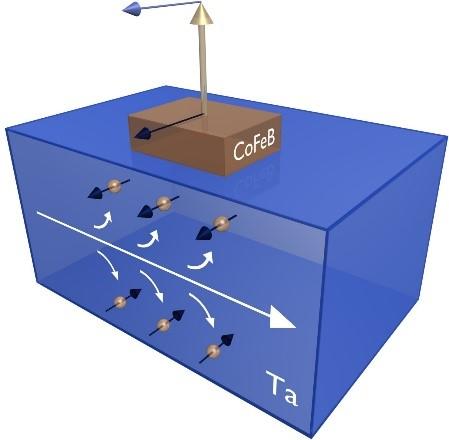Summary
The working of countless electronic devices involves electric and magnetic effects interacting within nanostructured materials. In the phenomenon known as spin-orbit torque, an electrical current flowing through a bilayer consisting of a heavy metal and a ferromagnet can give a jolt to the magnetization in the ferromagnet. The effect may make possible a novel kind of magnetic memory and other electronic devices. Harnessing the potential of spin-orbit torques requires both quantitative measurements of their effects and a refined theoretical understanding of these measurements, which is the goal of this project.
Description

A current (white arrow) flowing through a tantalum film generates a current of spins (dark blue arrows) that impinges on the ferromagnetic cobalt iron boron layer and causes the magnetization (gold arrow) to charge directions (light blue arrow).
A ferromagnetic material such as iron acquires its magnetization because the magnetic orientation of its constituent atoms all line up in the same way. Because individual electrons also have an intrinsic magnetic moment – which is often referred to as the electron “spin” - they can interact with ferromagnets in some unusual ways. For example, an electric current flows more easily through a ferromagnet if the spins of the flowing electrons are aligned with, rather than opposite to, the magnetization.
Magnetic tunnel junctions makes use of this effect. In these devices, two layers of a ferromagnet are separated by an electrical insulator that is only several atomic layers thick. Electrons can tunnel through this barrier to conduct electricity, but the resistance depends on whether the magnetizations in the two layers are parallel or antiparallel. Magnetic tunnel junctions store ones and zeros in the different alignments (parallel and antiparallel), and that information can be simply read by measuring the resistance. Such devices form the basis for magnetic random access memory (MRAM).
There is an additional effect by which the current doesn't merely respond to the magnetization of the layer but actually disturbs it. When an electron with misaligned moment passes into a magnetized material, the mismatch (misalignment) gives rise to a small twisting force -- a torque -- between the electron’s spin and the bulk magnet. This effect is known as a “spin transfer torque”. A large current can generate a torque big enough to change the bulk magnetization direction of the material it is passing through. The ability to control the state of MRAM devices (e.g. switching between parallel to anti-parallel alignment) by these spin-transfer torques is leading to increasing use of such devices in integrated circuits.
Recent excitement has emerged in this field from the discovery that spin-orbit coupling, the coupling between electrons' spins and their motion, provides new mechanisms for switching the magnetization. These effects raise the possibility of three terminal devices in addition to the two-terminal devices typically designed using spin-transfer torques. Even more possibilities arise from adding an additional ferromagnetic layer that allows for additional forms of torque.
In addition to memory devices like MRAM, theory shows that in certain situations the current-induced torques can cause the magnetization of a ferromagnetic layer to spin around, or precess, at a frequency controlled by the current. This technique could make possible gigahertz oscillators with a wide range of electronic uses.
The goal of our studies of spin-orbit torques is to advance theory to the point that it can reliably interpret measurements and enable rigorous and reliable predictions of how specific systems will perform in a range of possible device applications. We break down the intricate phenomenon into a series of steps. The first step is to use quantum physics to understand how a single electron interacts with a magnetized material. This information then feeds into models that describe the action of a current consisting of many electrons with different alignments. The final ingredient is to include the response of the magnetization to the influence of changing currents. The theoretical picture built up in this way can help engineers design novel devices and work out solutions to problems before entering into large-scale production.

